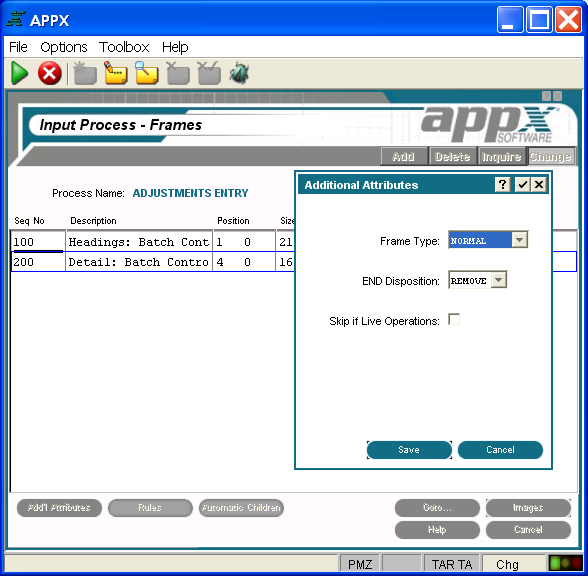Chapter 3-6: Input Processes |
Input Frame Additional Attributes Option When you select the Additional Attributes option on the Input Process Frames screen, the input process frame Additional Attributes overlay is displayed as shown below, where you can access additional parameters.
Input Frame Additional Attributes Overlay The input frame Additional Attributes overlay contains the following fields. Frame Type governs the execution of an image or images for the frame. There are three frame types. NORMAL ....... Executes the first (lowest numbered) alternate image unless another image is explicitly selected with statements and the predefined field ALTERNATE IMAGE NUMBER. OPTIONAL ..... Executes the image that is identified by the Normal Frame Type above, with the following exception: If the value in the predefined field ALTERNATE IMAGE NUMBER is 0, do not execute an image. REPEATING ... Executes the image repeatedly until the value in the ALTERNATE IMAGE NUMBER is set to 0 by statements. The default is Normal. See Frames for more information about optional and repeating frames.
END Disposition designates the effect on the image displayed for this frame of a user selecting the end HOLD .............. Causes APPX to automatically control the disposition of the frame. The image for the frame displays until the process cycle completes (until all frames execute for one PCF record), at which time the image is removed. CLEAR ............ Causes the contents of the frame to clear, but the image for the frame still exists and still obscures the contents of any prior images that it overlays on the screen. REMOVE ........ Causes the frame itself to be removed, and will no longer obscure the contents of any prior frames that it overlays on the screen. The default is REMOVE.
Skip If Live Operations? determines whether or not the frame is exclusive to the initial setup and recovery processing phases of operation. If 'yes' |
Application Design Manual "Powered by Appx Software"322 ©2006 By APPX Software, Inc. All Rights Reserved |
